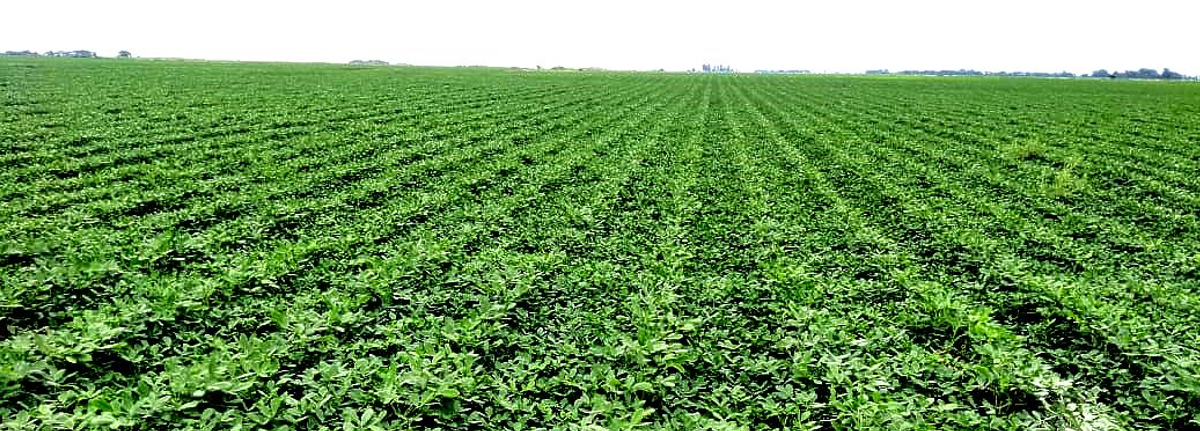Argentine Peanuts
Crop Evolution Report
February 2019
General Overview
The Argentine peanuts crop continues evolving well and according to the expectations. Despite low rainfall records during February, the first week of March brought relieving rains that allowed peanut plants in all the growing areas to leave behind the initial signs of water stress that had exhibited as a consequence of the low rainfall records. Consequently, the plants are undergoing the last stages of development in good conditions of moisture and temperature, pods are being filled abundantly, which implies that initial yield estimates are optimistic.

Image 1: Peanuts in La Pampa – Southern Area
Nonetheless, critical stages are still pending and on the radar: digging and harvesting. Good conditions are required to perform these tasks with optimum timing and efficacy. If those tasks can be performed without major issues, we may be looking at a very good crop in terms of quantity and quality. Even though the planted area in Argentina was reportedly reduced this year, yields could make it up for the reduction.

Image 2: Peanuts in Del Campillo – South-Central Area
In terms of crop condition, the Gastaldi’s team of agronomists have assigned the following califications:
• 68% of the crop has been graded as excellent or very good.
• 31% has been graded as good.
• Only 1% has been graded as bad.
This general classification clearly shows that the crop is evolving in line with the expectations.

Image 3: General peanut crop condition as of March 7th
Main Argentine Peanuts Area Map
The main peanut area in Argentina includes the provinces of Cordoba, La Pampa, San Luis and Buenos Aires. In general terms, it can be divided as follows:

Image 4: Argentine Peanut Map
Agricultural and climatic condition
Summarizing the climatic conditions that prevailed during February, we report that rainfall of varying magnitude was recorded in the different peanut-growing areas. Nonetheless, cumulative records throughout the second month of the year were much lower than those recorded in January.
The highest rainfall records were recorded in the North, whereas in the South-Central area, rainfall contributed to the attenuation of dry stress symptoms exhibited by plants that were in considerable need of water. It is worth noting that plants are going through the highest water demand stage of their growing cycle, so moisture requirements to achieve good yields are high. On the other hand, the Central area was the most affected one by the lack of water, which generated temporary stress in the plants. The stress situation arises due to the great vegetative structure achieved by peanuts, generating a great demand of nutrients to fill the pods with kernels. February ended up with lower rainfall records than the historical average.

Image 5: Cummulative rains in the Cordoba province – February 2019
On the other hand, as we entered the first week of March, relieving rains were gratefully received, especially during the last weekend. Records accounted for considerable rains and were distributed homogeneously in the entire Argentine peanut area. The timing couldn’t have been better, since plants were able to leave the initial signs of water stress behind. Good yields in most areas are ensured, so the spotlight now turns to the conditions in which digging and harvesting will be undertaken: hot and sunny days are required to achieve optimal results.

Image 6: Cummulative rains in the Cordoba province – 1st week of March 2019
As for the thermal records, normal values for this time of the year were recorded in February. Minimum temperatures hovered around 20 °C, while maximum temperatures were between 33 °C and 35 °C. During the last week of February, unusual frosts were recorded in the South and South-East of La Pampa and Buenos Aires, which led to great concern among the growers, as these remarkable low temperatures were highly unexpected. Nonetheless, the duration of the frost was not substantial, so damage was not of great consideration.

Image 7: Effects of the unusual frost in La Pampa on February 26th
Available water content in Cordoba
Soil moisture may reach its maximum retention capacity or field capacity (by which plants extract water without difficulty). Between field capacity and the permanent wilting point stands the range that we designate Useful Water in the Arable Layer. The chart depicts values ranging between 40% and 60% of useful water in the soil profile towards the end of February in the peanut-growing area (Field condition).
Source: FAUBA.

Image 8: Images comparing the available water content percentage on the same day and month of 2018 and 2019
Phenological development stages
Nowadays, in general terms, peanuts are going through advanced stage of pod filling. Peanuts in all areas are reportedly going through stages R5 and R6.

Image 9: General phenological crop condition as of February 28th

Image 10: Phenological crop condition by area as of February 28th
Peanut Development Stages
V1: first tetrafoliolate leaf
V2: second tetrafoliolate leaf
V3: third tetrafoliolate leaf
V4: fourth tetrafoliolate leaf
V – (N): one to N developed nodes on main axis
R1: beginning bloom
R2: beginning peg
R3: beginning pod
R4: full pod
R5: beginning seed
R6: full seed
R7: beginning maturity
R8: harvest maturity

Image 11: Peanuts in La Cesira – Eastern Area
Crop-related Tasks
Herbicide treatments for weed control were continued in all areas of our reference map. Growers and technicians began to plan the third application of fungicides to prevent foliar diseases (Leaf Spot). As of today, we find low rates of incidence and severity of this disease, but we must be alert because the lots have large amounts of inoculum on the surface.

Image 12: Peanuts in General Deheza – Central Area
Agricultural Issues
The most critical problem today is related to the presence of a pest called Red Spider mite (Tetranychus urticae). This plague appears when there is lack of water and begins to affect the plant by creating a soft pale discoloration, which later turns into totally “brownish” leaflets. The disease is irreversible and in the best scenario, the recovery can only be minimal. The damage would persist even after it has rained considerably and the plague has been efficiently controlled.

Image 13: Influence of the red spider in the peanut plant
On the other hand, a disease called Sclerotinia sp. has also been spotted, although it does not constitue a significant risk, as of the date of this report. This disease characteristically generates a white mold on the neck of the plant where the sclerotia grows, weakening the connecting wires between the plant and the shell, thus increasing the losses at the time of digging. A correct monitoring of the disease’s development is key to define the most appropriate moment to dig the peanuts.
There are currently no problems in the management of foliar diseases, but the rotation of fungicides will be of vital importance in order to avoid resistance.
Final Remarks
As we approach the end of the peanut-growing cycle in Argnetina, the perspectives of the crop in terms of yields and quality are promising. The important rainfall figures, that were recorded in January and the beginning of March mainly, ensure that average yields will be higher than those of the previous year, when “the worst crop in 50 years” took place. These promising yields could contribute to offset the sharp reduction in the planted area that was reported at the beginning of the season. Despite the presence of typical issues for this time of the year such weeds, pests and diseases, agronomists report very good conditions in most of the peanut fields.
It is worth noting that these optimistic expectations should be taken with a good deal of precaution, since the peanut cycle is not complete yet. Digging and harvesting are the next milestones to achieve, so good weather conditions are required.

Image 14: Peanuts in La Cesira – Eastern Area

Image 15: Peanuts in Piquillin – Northearn Area
Do you have a commercial inquiry? Request for price quote
Other questions or comments? Contact us stembras@gastaldihnos.com.ar



